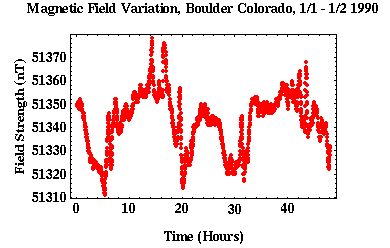Diurnal Variations of the Earth's Magnetic Field
Of more importance to exploration geophysical surveys are the daily, or diurnal, variations of the Earth's magnetic field. These variations were first discovered in 1722 in England when it was also noted that these daily variations were larger in summer than in winter.
The plot below shows typical variations in the magnetic data recorded at a single location (Boulder,
Colorado) over a time period of two days.
Although there are high-frequency components to this variation, notice that the dominant trend
is a slowly varying component with a
period
of about 24 hours. In this location, at this time, the amplitude of this daily variation is about 20 nT.

These variations are believed to be caused by electric currents induced in the Earth from an external source. In this case, the external source is believed to be electric currents in the upper atmosphere, or the ionosphere. These electric currents in the ionosphere are in turn driven by solar activity.
Given the size of these variations, the size of the magnetic anomalies we would expect in a typical geophysical survey, and the fact that surveys could take several days or weeks to complete, it is clear that we must account for diurnal variations when interpreting our magnetic data.